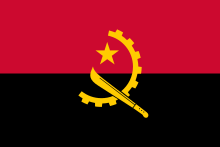| People's Armed Forces of Liberation of Angola | |
|---|---|
| Forças Armadas Populares de Libertação de Angola | |
 | |
| Founded | 1974 |
| Disbanded | 1993 |
| Service branches | |
| Leadership | |
| Commander-in-Chief | President José Eduardo dos Santos |
| Minister of Defence | General Pedro Tonho Pedale (last) |
| FAPLA chief of the general staff and army commander | Lieutenant General António dos Santos França (1982-1989)[1][2] |
| Industry | |
| Foreign suppliers | Soviet Union |
| Related articles | |
| History | Angolan War of Independence South African Border War Angolan Civil War |
The People's Armed Forces of Liberation of Angola (Portuguese: Forças Armadas Populares de Libertação de Angola) or FAPLA was originally the armed wing of the People's Movement for the Liberation of Angola (MPLA) but later (1975–1991) became Angola's official armed forces when the MPLA took control of the government.
Its major adversaries were the National Union for the Total Independence of Angola (UNITA), its armed wing, the Armed Forces of Liberation of Angola (FALA), and the South African Defence Force (SADF). The FAPLA fought the SADF and UNITA/FALA constantly from the 1970s, part of the Angolan Civil War and the South African Border War, including during Operation Savannah (1975-76), and Operation Sceptic (1980). The Battle of Cuito Cuanavale (1987-1988) was the largest land battle in Africa since the Second World War.
After the Bicesse Accords in 1993, the FAPLA were transformed in the Angolan Armed Forces (Forças Armadas de Angola, FAA), by the integration of UNITA and FALA members.
- ^ Collelo 1991, p. 215.
- ^ Defense Intelligence Agency, Military Intelligence Summary - Africa South of the Sahara, DDB 2680-104-85, ICOD 15 October 1984, Angola